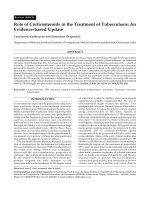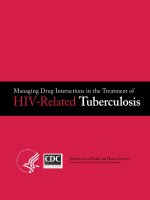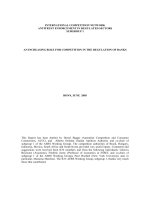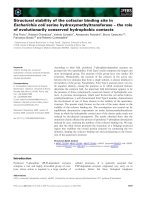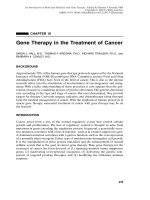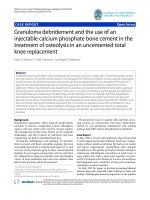Role of Corticosteroids in the Treatment of Tuberculosis: An Evidence-based Update potx
Bạn đang xem bản rút gọn của tài liệu. Xem và tải ngay bản đầy đủ của tài liệu tại đây (158.38 KB, 6 trang )
Role of Corticosteroids in the Treatment of Tuberculosis: An
Evidence-based Update
Tamilarasu Kadhiravan and Surendran Deepanjali
Department of Medicine, Jawaharlal Institute of Postgraduate Medical Education and Research, Puducherry, India
ABSTRACT
Corticosteroids are often used as an adjunct in the treatment of various forms of tuberculosis (TB) and for the prevention
of complications, such as constrictive pericarditis, hydrocephalus, focal neurological deficits, pleural adhesions, and intestinal
strictures. Notwithstanding, they have been proven in clinical trials to improve the following outcomes only — death or
disability in human immunodeficiency virus (HIV)-seronegative patients with tubercular meningitis and tubercular
pericarditis. Despite a lack of specific evidence for efficacy in HIV co-infected patients with tubercular meningitis or
pericarditis, corticosteroids are generally recommended in them as well. Corticosteroids significantly decrease the risk of
pleural thickening in patients with tubercular pleural effusion; the clinical significance of this finding, however, is unclear.
Recently, it has been demonstrated that use of corticosteroids improve the morbidity in HIV co-infected patients with
paradoxical TB immune reconstitution inflammatory syndrome (IRIS). However, evidence favouring the use of
corticosteroids in other clinical situations is sparse or lacking. Likewise, the biological mechanisms underlying their beneficial
effect in TB meningitis and pericarditis remain poorly understood. [Indian J Chest Dis Allied Sci 2010;52:153-158]
Key words: Glucocorticoids; HIV infection; Immune reconstitution inflammatory syndrome; Treatment outcome;
Tuberculosis
INTRODUCTION
Corticosteroids (specifically glucocorticoids) have
been used as an adjunct in the treatment of various
forms of tuberculosis (TB) for about six decades now.
While considerable scepticism exists regarding their
efficacy, corticosteroids are often over-prescribed in
actual practice hoping to prevent the sequelae of TB,
such as intestinal strictures and constrictive
pericarditis. Ever since the authoritative review on
this topic by Dooley et al
1
was published, several large
randomised controlled trials (RCTs) have been
conducted, and at least three Cochrane systematic
reviews have been performed. In the present article,
we present an overview of these developments and
also address the gaps in current evidence.
The landmark British Medical Research Council
trial of streptomycin for the treatment of pulmonary
TB was published in the year 1948.
2
Incidentally, in
the same year Philip Hench and colleagues
3
discovered the anti-inflammatory properties of
cortisone. The worldwide popularity brought about
by the award of Nobel prize to this discovery
4
perhaps inspired the early attempts to use
corticosteroids for the treatment of TB despite a lack
of empirical evidence. Rather, data from animal
experiments actually suggested that the use of
corticosteroids might worsen the disease.
5
This
prompted the American Thoracic Society (then known
as the American Trudeau Society) to caution against
using corticosteroids in TB.
6
Soon, reports of
reactivation and dissemination of TB in humans
following corticosteroid use started appearing in the
literature.
7,8
Undaunted by these setbacks, some
investigators
9
demonstrated that clinical outcomes in
certain forms of extrapulmonary TB (particularly
meningitis) could potentially be improved by the
concurrent use of antimycobacterial agents
(streptomycin with paraaminosalicylic acid) and
corticosteroids. Many of the early clinical studies also
focused on the use of corticosteroids in pulmonary TB.
However, the advent of combination chemotherapy
dramatically improved the outcomes in pulmonary
TB to such an extent that corticosteroids were almost
abandoned as an adjunct in pulmonary TB. On the
other hand, common occurrence of adverse outcomes
such as death, neurological disability, and fibrotic
sequelae such as pleural fibrosis/loculations,
constrictive pericarditis, and strictures of hollow
viscera such as the intestine and ureter despite
[Received: June 2, 2010, accepted: June 8, 2010]
Correspondence and reprint requests: Dr Tamilarasu Kadhiravan, Assistant Professor, Department of Medicine, Jawaharlal
Institute of Postgraduate Medical Education and Research (JIPMER), Dhanvantri Nagar, Puducherry - 605 006, India;
Phone: 91-9488819978; Fax: 91-413-2272067; E-mail:
Review Article
effective antimycobacterial treatment has kept alive
the quest for adjunctive treatments in extrapulmonary
TB.
CORTICOSTEROIDS IN TUBERCULAR
MENINGITIS
Tubercular meningitis (TBM) is uniformly fatal if not
treated. An earlier Cochrane systematic review
10
concluded that corticosteroids significantly improved
the mortality among children with TBM while the
effect on mortality in adults was inconclusive.
Recently, Thwaites and colleagues
11
had carried out
the largest-ever RCT of corticosteroids in adolescents
and adults with TBM in Vietnam. Following the
publication of this trial, Prasad and Singh
12
updated
their Cochrane systematic review on the efficacy of
corticosteroids in TBM.
12
The combined mortality in
the control arms (anti-tuberculosis treatment [ATT]
only) of the seven RCTs included in this systematic
review was 40%; the overall disability-free survival
was only 48 percent. Thus, in patients with TBM, risk
of death and residual disability still remains very
high despite the use of combination chemotherapy
regimens that otherwise have more than 95% efficacy
in new sputum smear-positive pulmonary TB cases.
The poor outcomes are often attributed to the
development of complications, such as hydro-
cephalus, arachnoiditis, and vasculitic infarcts, as a
result of unbridled inflammation.
Corticosteroids have been found to significantly
decrease the risk of death by 22% (relative risk
reduction) and improve the disability-free survival by
about 22% in TBM
12
(Figure). Treating about 13
patients with corticosteroids in addition to ATT could
prevent one additional death in TBM.
12
Contrary to
conventional knowledge, Prasad and Singh
12
found
that corticosteroids confer a survival benefit
irrespective of the severity of TBM. On the other
hand, evidence to use of corticosteroids in human
immunodeficiency virus (HIV) co-infected patients
with TBM is scanty. Only one RCT
11
had included
patients with HIV-associated TBM. In this study,
subgroup analysis failed to demonstrate a statistically
significant benefit of corticosteroids in HIV-
associated TBM.
Central nervous system TB may at times present as
focal space-occupying lesions of the brain
parenchyma or the spinal cord (tuberculoma) with or
without evidence of meningitis. Anecdotal reports
suggest that corticosteroids might hasten symptomatic
improvement when tuberculoma results in mass effect
or refractory seizures.
13
However, efficacy of
corticosteroids in this clinical setting has not been
formally evaluated in clinical trials. Paradoxically,
tuberculoma may develop in patients being treated for
TBM despite the use of adjunctive corticosteroids.
CORTICOSTEROIDS IN TUBERCULAR
PERICARDITIS
As with TBM, patients with tubercular pericarditis
often develop complications such as cardiac
tamponade and constrictive pericarditis necessitating
therapeutic interventions. In addition, tubercular
pericarditis is associated with a considerable mortality
of about 15%, and only about two-third of patients
(66%) survive without disability at two years.
14,15
Four
RCTs have evaluated the role of corticosteroids in TB
pericarditis; one of them was exclusively for HIV co-
infected patients.
16
A meta-analysis of these trials
found that corticosteroids decreased the risk of all-
cause mortality by 35% (relative risk reduction) in HIV-
seronegative patients with tubercular pericarditis.
17
However, this reduction failed to achieve statistical
significance. Likewise, corticosteroids did not
significantly reduce the need for pericardiectomy
(Figure). Nonetheless, corticosteroids resulted in a
modest 45% improvement in disability-free survival at
two years with considerable heterogeneity among the
trials.
17
Strang et al
18
reported in a long-term follow-up
of the Transkei trial participants that the apparent
clinical benefit of corticosteroids was maintained even
10 years after treatment. Although it may not be a valid
interpretation, it seems that the clinical benefit of
corticosteroids, if any, is attenuated in patients with
established constrictive pericarditis as compared to
those with effusive tubercular pericarditis.
17
Figure. A composite illustration of summary effect-sizes
(relative risk 95% CI) for different outcomes reported in
the Cochrane systematic reviews on efficacy of
corticosteroids in various forms of extrapulmonary TB. The
dotted vertical line represents the line of ‘no difference’.
(Data adapted from Prasad and Singh
12
, Mayosi
17
, and Engel
et al
20
)
ATT=Anti-tuberculosis treatment
154 Corticosteroids in Tuberculosis T. Kadhiravan and S. Deepanjali
The only trial of corticosteroids in HIV co-infected
patients with tubercular pericarditis found a 50%
relative reduction in all-cause mortality; however, this
improvement was not statistically significant.
17
CORTICOSTEROIDS IN TUBERCULAR
PLEURAL EFFUSION
Most tubercular pleural effusions resolve
spontaneously even without specific ATT.
19
However,
the resolution is often incomplete leaving behind
loculated collections and considerable pleural
thickening. It is believed that corticosteroids might
reduce these fibrotic sequelae and hasten the
resolution of pleural effusion as well as clinical
symptoms. In a Cochrane systematic review, Engel et
al
20
found that corticosteroid use had no appreciable
effect on the resolution of pleural effusion at eight
weeks and development of pleural adhesions.
However, two small trials
21,22
found that
corticosteroids significantly decreased the duration
of clinical symptoms by about 4.3 days.
Unexpectedly, Engel et al
20
found that corticosteroids
significantly reduced the risk of pleural thickening by
about 31% (Figure). It is worth noting that two of the
four trials that assessed pleural thickening had also
compared the pulmonary functions by forced vital
capacity at the end of treatment between the
corticosteroid and control arms.
23,24
Discordant with
the effect on pleural thickening, no significant
improvement in pulmonary functions was found.
Thus, the clinical significance of the reduction in
pleural thickening by corticosteroids is questionable.
Only one trial
25
was conducted in HIV co-infected
patients with TB pleural effusion. In this trial, use of
corticosteroids was associated with faster clinical as
well as radiological improvement. However, it was
also associated with a significantly increased risk of
Kaposi’s sarcoma and a non-significant but higher
risk of recurrent TB.
CORTICOSTEROIDS IN OTHER FORMS
OF EXTRAPULMONARY TB
Credible evidence from clinical trials for the use of
corticosteroids in other infrequent forms of TB, such as
genitourinary TB and laryngeal TB, is sparse. Scanty
evidence does exist on the use of adjunctive
corticosteroids in peritoneal TB, miliary TB, and
mediastinal TB lymphadenitis.
1
However, they are all
inconclusive in nature. A small RCT
26
of 47 patients
with peritoneal TB from India found a non-significant
reduction in the development of late fibrotic
complications (symptomatic intestinal obstruction).
Likewise, another trial
27
of corticosteroids in 55 patients
with miliary TB found a statistically non-significant
reduction in mortality. Acute respiratory distress
syndrome (ARDS) occasionally complicates the clinical
course of pulmonary and miliary forms of TB.
28
Most
patients with TB-related ARDS succumb to the illness.
Corticosteroids might be used in such settings as a
desperate measure despite a lack of specific evidence,
which is unlikely to be ever generated.
For obvious reasons, clinically manifest adrenal
insufficiency as a result of TB is an absolute
indication for corticosteroids. On the other hand,
corticosteroid replacement may not be necessary for
subclinical adrenal insufficiency which is common
among patients with pulmonary as well as
extrapulmonary TB. Adrenal function recovers in
most of these patients with ATT alone.
29
However, it
is worth exploring whether correcting the subclinical
adrenal insufficiency, if present, could improve the
short-term mortality in critically-ill patients with TB.
Corticosteroids in Pulmonary TB
Several RCTs have been conducted in the past to
evaluate the effect of corticosteroids in pulmonary TB.
Smego and Ahmed
30
in a systematic review on this
topic identified 11 such trials. However, we did not
come across any new published trial after this
systematic review. Although many trials found
significantly faster clinical and radiological
improvement in patients treated with adjunctive
corticosteroids, it is important to note that only two of
these 11 trials had used rifampicin-based regimens.
Of the two trials that used rifampicin-based regimens,
one was a fairly larger one with 530 sputum smear-
positive patients conducted at the Tuberculosis
Research Centre, Chennai.
31
Interestingly, in this trial
corticosteroids had no significant effect on
radiological and bacteriological responses. Thus, the
role of corticosteroids in pulmonary TB when used
alongside modern-day rifampicin-based regimens is
questionable. Notwithstanding, these trials do bring
out a fact that bacteriological response will not be
adversely affected by concurrent use of
corticosteroids and effective ATT; only one of the 11
trials found delayed sputum conversion with
corticosteroids.
30
However, it needs to be cautioned
that this finding might not hold true for patients with
drug-resistant TB.
31
Anecdotal reports suggest that corticosteroids
might be beneficial in patients with endobronchial
TB. However, in one trial
32
of 34 patients with
endobronchial TB, corticosteroids had no appreciable
effect on bronchoscopic healing rate, radiological
findings, and pulmonary functions.
Corticosteroids in HIV-related TB
Evidence from clinical trials on the use of
corticosteroids in specific forms of HIV-related
extrapulmonary TB has been dealt with earlier.
Immune reconstitution inflammatory syndrome (IRIS)
2010;Vol.52 The Indian Journal of Chest Diseases & Allied Sciences 155
reactions occur commonly in HIV co-infected patients
with TB. While most instances of IRIS reactions are
self-limited and respond to non-steroidal anti-
inflammatory drugs, corticosteroids may be used to
treat severe TB-IRIS reactions and those unresponsive
to non-steroidal anti-inflammatory drugs.
33
In a
recently concluded RCT
34
of 109 HIV co-infected
patients with paradoxical TB-IRIS, corticosteroids
modestly improved the composite outcome of
duration of hospital stay and outpatient therapeutic
procedures (counted as one additional day of
hospitalisation). Further, corticosteroids also
improved secondary outcomes, such as symptom
score, performance status, quality of life, radiological
severity, and C-reactive protein level. However, this
trial was not powered to detect a difference in
mortality between the two groups.
BIOLOGICAL MECHANISMS UNDERLYING
THE CLINICAL BENEFIT OF
CORTICOSTEROIDS
While it is simple and logical to conceive that
corticosteroids improve the clinical outcomes in TB
by suppressing the host-mediated inflammation,
direct evidence for such an effect in humans has
proved elusive. An earlier RCT
35
in children with
TBM had found that corticosteroids resulted in faster
recovery of cerebrospinal fluid (CSF) glucose levels
and faster resolution of elevated CSF protein, while it
had no effect on CSF pleocytosis. Very recently,
Simmons et al
36
found that the clinical benefit of
corticosteroids in the Vietnam TBM trial was not
accompanied by a measurable suppression of
immune responses both in the peripheral blood as
well as the CSF. Serial magnetic resonance imaging of
the brain was also performed in a subset of patients
in this study.
36
It was found that use of corticosteroids
possibly reduced the risk of developing
hydrocephalus and vasculitic infarcts; however, these
findings were not statistically significant due to
inadequate sample size.
37
Matrix metalloproteinase-9 (MMP-9) and vascular
endothelial growth factor (VEGF) are purported to
play an important role in the disruption of the blood-
brain barrier in TBM. Corticosteroids significantly
reduce the CSF levels of MMP-9 in patients with
TBM.
38
Corticosteroids also inhibit Mycobacterium
tuberculosis-induced production of VEGF in vitro.
39
However, clinical significance of these laboratory
findings is unclear.
Thus, while credible evidence exists to support the
beneficial effects of corticosteroids in TB, specifically
TBM, the exact mechanisms of such benefit remain
poorly understood.
40
Thwaites et al
11
have put
forward an interesting hypothesis to explain the
clinical benefit of corticosteroids in TBM. They
observed that treatment-limiting adverse events that
necessitated a change in ATT were less common in
the corticosteroid arm, and such changes in ATT
were independently associated with death on
multivariable analysis.
11
Based on these findings,
they proposed that “dexamethasone may improve
outcomes by reducing the frequency of adverse events
that necessitate a change in the antituberculosis-drug
dose or regimen - severe clinical hepatitis, in
particular.”
11
This hypothesis needs verification in
future studies.
EVIDENCE-BASED RECOMMENDATIONS
From the foregoing discussion, it emerges that the only
clinical indication for which corticosteroids have
been demonstrated to be beneficial beyond reasonable
doubt is TBM, especially in HIV-seronegative patients.
Thus, corticosteroids are recommended in all HIV-
seronegative patients with TBM irrespective of age
and clinical stage (Table). While specific evidence for
efficacy among HIV co-infected patients is lacking, it
is reasonable to use corticosteroids to treat HIV co-
infected patients with TBM as well.
41
Table. Recommended dosage regimens of corticosteroids in
extrapulmonary TB.
41,42
(Adapted from Thwaites et al
11
)
Clinical Condition Regimen
Tubercular meningitis Total duration 6 weeks
(Stage 1)* Inj. Dexamethasone 0.3 mg/kg i.v.
Day 1-7;
0.2mg/kg i.v. Day 8-14; 0.1 mg/kg i.v.
Day 15-21
Followed by Tab. Dexamethasone
3 mg/day orally Days 22-28;
2 mg/day orally Day 29-35;
1 mg/day orally Day 36-42
Tubercular meningitis Total duration 8 weeks
(Stages 2 and 3)* Inj. Dexamethasone 0.4 mg/kg i.v.
Day 1-7;
0.3 mg/kg i.v. Day 8-14;
0.2 mg/kg i.v. Day 15-21;
0.1 mg/kg Day 22-28
Followed by Tab. Dexamethasone
4 mg/day orally Days 29-35;
3 mg/day orally Day 36-42;
2 mg/day orally Day 43-49;
1 mg/day orally Day 50-56
Tubercular pericardial Total duration 11 weeks
effusion Tab. Prednisolone 60 mg/day
†
orally
Day 1-28;
30 mg/day
†
orally Day 29-56;
15 mg/day
†
orally Day 57-70;
5 mg/day orally Day 71-77
*=Stage 1, Glasgow coma scale (GCS) score 15 and no focal
neurological deficits; Stage 2, GCS score 11-14 or focal
neurological deficits present; Stage 3, GCS score less than 11
†
=Administered as three divided doses in the Transkei
trials;
14,15
i.v.=intravenous.
156 Corticosteroids in Tuberculosis T. Kadhiravan and S. Deepanjali
Corticosteroids seem to have a potential benefit in
patients with tubercular pericarditis. However, more
robust evidence is required. Meanwhile, it is prudent
to use corticosteroids in patients with tubercular
pericarditis (both effusive and constrictive)
irrespective of the HIV serostatus
42
(Table). However,
these recommendations are likely to change with the
availability of more clinical evidence in the future. On
the other hand, although it has been found that
corticosteroids reduced the risk of pleural thickening,
clinical significance of this benefit is unclear. Hence,
the use of corticosteroids is not recommended in
tubercular pleural effusion.
CONCLUSIONS
Adverse outcomes are common among patients with
extrapulmonary TB despite the availability of
effective anti-tubercular treatment. Corticosteroids
might potentially improve these adverse outcomes
when used as adjunctive treatment. However, the
available evidence indicates meaningful clinical
benefits only in patients with TBM or tubercular
pericarditis. More evidence is required on the
efficacy of corticosteroids in other forms of
extrapulmonary TB. Further, the biological
mechanisms underlying the clinical benefit of
corticosteroids in TB need to be elucidated.
ACKNOWLEDGEMENTS
TK gratefully acknowledges the mentoring by Professor
S.K. Sharma, Department of Medicine, All India Institute of
Medical Sciences, New Delhi.
REFERENCES
1. Dooley DP, Carpenter JL, Rademacher S. Adjunctive
corticosteroid therapy for tuberculosis: a critical
reappraisal of the literature. Clin Infect Dis 1997;25:872-87.
2. British Medical Research Council. Streptomycin treatment
of pulmonary tuberculosis. Br Med J 1948;2:769-82.
3. Mayo Clinic. Cortisone discovery and the Nobel prize.
Available at: />heritage/cortisone-discovery.html. Accessed: April 16,
2010.
4. The Nobel Foundation. The Nobel prize in physiology or
medicine 1950. Available at: />nobel_prizes/medicine/laureates/1950/. Accessed: April
16, 2010.
5. D’Arcy-Hart P, Rees RJ. Enhancing effect of cortisone on
tuberculosis in the mouse. Lancet 1950;2:391-5.
6. American Trudeau Society. Bull Natl Tuberc Assoc 1951,
p4. (Cited in: Capon AW. ACTH, cortisone and
tuberculosis. Can Med Assoc J 1952;67:46-8.
7. Kleinschmidt RF, Johnston JM. Miliary tuberculosis in a
cortisone treated patient: case report with autopsy. Ann
Intern Med 1951;35:694-702.
8. King EQ, Johnson JB, Batten GS, Henry WL. Tuberculosis
following cortisone therapy: report of a case of rapidly
progressive pulmonary tuberculosis following cortisone
therapy for rheumatoid arthritis. J Am Med Assoc
1951;147:238-41.
9. Copp SE, Krzyski TK, Shane SJ. Tuberculous meningitis:
combined corticosteroid and antimicrobial therapy. Can
Med Assoc J 1956;75:631-4.
10. Prasad K, Volmink J, Menon GR. Steroids for treating
tuberculous meningitis. Cochrane Database Syst Rev
2000;3:CD002244.
11. Thwaites GE, Nguyen DB, Nguyen HD, Hoang TQ, Do
TT, Nguyen TC, et al. Dexamethasone for the treatment of
tuberculous meningitis in adolescents and adults. N Engl
J Med 2004;351:1741-51.
12. Prasad K, Singh MB. Corticosteroids for managing
tuberculous meningitis. Cochrane Database Syst Rev
2008;1:CD002244.
13. Afghani B, Lieberman JM. Paradoxical enlargement or
development of intracranial tuberculomas during therapy:
case report and review. Clin Infect Dis 1994;19:1092-9.
14. Strang JI, Kakaza HH, Gibson DG, Girling DJ, Nunn AJ,
Fox W. Controlled trial of prednisolone as adjuvant in
treatment of tuberculous constrictive pericarditis in
Transkei. Lancet 1987;2:1418-22.
15. Strang JI, Kakaza HH, Gibson DG, Allen BW, Mitchison
DA, Evans DJ, et al. Controlled clinical trial of complete
open surgical drainage and of prednisolone in treatment of
tuberculous pericardial effusion in Transkei. Lancet
1988;2:759-64.
16. Hakim J, Ternouth I, Mushangi E, Siziya S, Robertson V,
Malin A. Double-blind randomised placebo-controlled
trial of adjuvant prednisolone in the treatment of effusive
tuberculous pericarditis in HIV seropositive patients. Heart
2000;84:183-8.
17. Mayosi BM. Interventions for treating tuberculous
pericarditis. Cochrane Database Syst Rev 2002;4:CD000526.
18. Strang JI, Nunn AJ, Johnson DA, Casbard A, Gibson DG,
Girling DJ. Management of tuberculous constrictive
pericarditis and tuberculous pericardial effusion in
Transkei: results at 10 years follow-up. QJM 2004;97:525-
35.
19. Light RW. Tuberculous pleural effusions. In: Pleural
Diseases; 3rd edn. Baltimore: Williams & Wilkins; 1995:
p.154-66.
20. Engel ME, Matchaba PT, Volmink J. Corticosteroids for
tuberculous pleurisy. Cochrane Database Syst Rev
2007;4:CD001876.
21. Lee CH, Wang WJ, Lan RS, Tsai YH, Chiang YC.
Corticosteroids in the treatment of tuberculous pleurisy: a
double-blind, placebo-controlled, randomized study. Chest
1988;94:1256-9.
22. Bang JS, Kim MS, Kwak SM, Cho CH. Evaluation of
steroid therapy in tuberculous pleurisy: a prospective,
randomized study. Tuberc Respir Dis 1997;44:52-8.
23. Galarza I, Canete C, Granados A, Estopa R, Manresa F.
Randomised trial of corticosteroids in the treatment of
tuberculous pleurisy. Thorax 1995;50:1305-7.
24. Wyser C, Walzl G, Smedema JP, Swart F, van Schalkwyk
EM, van de Wal BW. Corticosteroids in the treatment of
tuberculous pleurisy: a double-blind, placebo-controlled,
randomized study. Chest 1996;110:333-8.
25. Elliott AM, Luzze H, Quigley MA, Nakiyingi J,
Kyaligonza S, Namujju PB, et al. A randomized, double-
blind, placebo-controlled trial of the use of prednisolone as
an adjunct to treatment in HIV-1-associated pleural
tuberculosis. J Infect Dis 2004;190:869-78.
26. Singh MM, Bhargava AN, Jain KP. Tuberculous
peritonitis: an evaluation of pathogenetic mechanisms,
diagnostic procedures and therapeutic measures. N Engl J
Med 1969;281:1091-4.
2010;Vol.52 The Indian Journal of Chest Diseases & Allied Sciences 157
27. Sun TN, Yang JY, Zheng LY, Deng WW, Sui ZY.
Chemotherapy and its combination with corticosteroids in
acute miliary tuberculosis in adolescents and adults:
analysis of 55 cases. Chin Med J 1981;94:309-14.
28. Sharma SK, Mohan A, Banga A, Saha PK, Guntupalli KK.
Predictors of development and outcome in patients with
acute respiratory distress syndrome due to tuberculosis.
Int J Tuberc Lung Dis 2006;10:429-35.
29. Sharma SK, Tandan SM, Saha PK, Gupta N, Kochupillai
N, Misra NK. Reversal of subclinical adrenal insufficiency
through antituberculosis treatment in TB patients: a
longitudinal follow up. Indian J Med Res 2005;122:127-31.
30. Smego RA, Ahmed N. A systematic review of the
adjunctive use of systemic corticosteroids for pulmonary
tuberculosis. Int J Tuberc Lung Dis 2003;7:208-13.
31. Tuberculosis Research Centre. Study of chemotherapy
regimens of 5 and 7 months’ duration and the role of
corticosteroids in the treatment of sputum-positive
patients with pulmonary tuberculosis in South India.
Tubercle 1983;64:73-91.
32. Park IW, Choi BW, Hue SH. Prospective study of
corticosteroid as an adjunct in the treatment of
endobronchial tuberculosis in adults. Respirology
1997;2:275-81.
33. Kaplan JE, Benson C, Holmes KH, Brooks JT, Pau A,
Masur H. Guidelines for prevention and treatment of
opportunistic infections in HIV-infected adults and
adolescents: recommendations from CDC, the National
Institutes of Health, and the HIV Medicine Association of
the Infectious Diseases Society of America. MMWR
Recomm Rep 2009;58(RR-4):1-207.
34. Meintjes G, Wilkinson R, Morroni C, Pepper D, Rebe K,
Rangaka M, et al. Randomised placebo-controlled trial of
prednisone for the TB immune reconstitution
inflammatory syndrome [Abstract 34]. In: Proceedings of
the 16th Conference on Retroviruses and Opportunistic
Infections; 2009 Feb 8-11; Montreal, Canada. Available at:
/>[Accessed May 25, 2010].
35. Schoeman JF, Elshof JW, Laubscher JA, Janse van
Rensburg A, Donald PR. The effect of adjuvant steroid
treatment on serial cerebrospinal fluid changes in
tuberculous meningitis. Ann Trop Paediatr 2001;21:299-
305.
36. Simmons CP, Thwaites GE, Quyen NT, Chau TT, Mai PP,
Dung NT, et al. The clinical benefit of adjunctive
dexamethasone in tuberculous meningitis is not
associated with measurable attenuation of peripheral or
local immune responses. J Immunol 2005;175:579-90.
37. Thwaites GE, Macmullen-Price J, Tran TH, Pham PM,
Nguyen TD, Simmons CP, et al. Serial MRI to determine
the effect of dexamethasone on the cerebral pathology of
tuberculous meningitis: an observational study. Lancet
Neurol 2007;6:230-6.
38. Green JA, Tran CT, Farrar JJ, Nguyen MT, Nguyen PH,
Dinh SX, et al. Dexamethasone, cerebrospinal fluid matrix
metalloproteinase concentrations and clinical outcomes in
tuberculous meningitis. PLoS One 2009;4:e7277.
39. van der Flier M, Hoppenreijs S, van Rensburg AJ, Ruyken
M, Kolk AH, Springer P, et al. Vascular endothelial growth
factor and blood-brain barrier disruption in tuberculous
meningitis. Pediatr Infect Dis J 2004;23:608-13.
40. van de Beek D. Brain teasing effect of dexamethasone.
Lancet Neurol 2007;6:203-4.
41. Thwaites G, Fisher M, Hemingway C, Scott G, Solomon T,
Innes J. British Infection Society guidelines for the
diagnosis and treatment of tuberculosis of the central
nervous system in adults and children. J Infect
2009;59:167-87.
42. Blumberg HM, Burman WJ, Chaisson RE, Daley CL,
Etkind SC, Friedman LN, et al. American Thoracic
Society/Centers for Disease Control and Prevention/
Infectious Diseases Society of America: treatment of
tuberculosis. Am J Respir Crit Care Med 2003;167:603-62.
158 Corticosteroids in Tuberculosis T. Kadhiravan and S. Deepanjali



